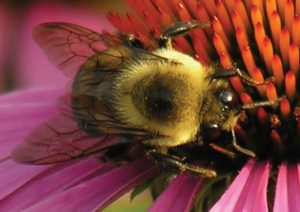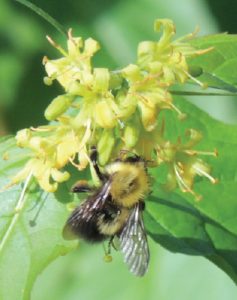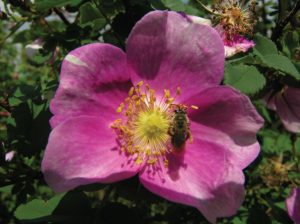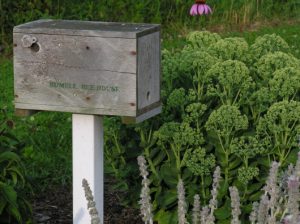How to Create a Bee-Friendly Landscape
Prepared by horticulturist Dr. Lois Berg Stack, entomologist Dr. Frank Drummond, and botanist Dr. Alison C. Dibble.

A bee-friendly landscape
- shelters and feeds native bees
- helps support honey bees
- ensures good pollination of your vegetables and fruits
- provides season-long beauty, diversity, and interest
Why should you develop a bee-friendly landscape?
Bees are important to nature and to the human diet. In Maine, bees are the most important pollinators of fruits and nuts.
Bees need pollen and nectar from flowers in order to live and reproduce. In urban landscapes, many flowering plants common in native plant communities have been largely replaced by houses, roads, and relatively flower-less landscapes dominated by lawns. This makes it tough for bees.
Trees, shrubs, fruits, vegetables and flower gardens in our landscapes can be important sources of nectar and pollen for the more than 250 species of native Maine bees, and for introduced honey bees.
Bee-friendly landscapes are places where bees can forage, build nests, and rear their young. When they forage for nectar and pollen, they help plants produce seeds and fruits for reproduction. We benefit from this when we eat apples, blueberries, cucumbers, cranberries, pumpkins, squashes and other crops that depend on bees for pollination.
It’s all about habitat

1. Bees need food
Plant multiple pollen- and nectar-producing plants for each season. Bees need food from early spring through late fall. When possible, plant native plants.
Early-season
- Trees: maples, apples, shadbush, willows, cherries, plums, native honeysuckles
- Perennials: blueberries, bugloss, lungwort, pigsqueak, crocus, viola
Midseason
- Shrubs: spirea, rose, summersweet, rosebay rhododendron
- Perennials: milkweed, purple coneflower, blazingstar, mint, oregano
- Annuals: single-flowered marigold, borage, tickseed, blanketflower

Late season
- Perennials: aster, bottle gentian, phlox, yellow and purple coneflowers, goldenrod
- Annuals: cosmos, snapdragon
2. Bees need water
Float a piece of wood in a birdbath to provide a landing platform. Change water frequently, both for the bees and the birds.
3. Bees need cover
Provide a variety of sites to accommodate a variety of bees. Leave bare patches of ground for those native bees that build nests in soil. Bunch grasses might attract bumble bees, which occupy old mouse nests. Build a nest block (see For more information) or hang bundles of dried hollow sunflower stems to attract cavity-nesting native bees.
Design tips for your bee-friendly landscape
-

Bee nest boxes are decorative and useful. Bees are attracted to large patches of flowers; plant them in areas of 3 feet x 3 feet, or larger.
- Provide plantings that bloom at various times throughout the season, to attract a diversity of bees.
- Garden without pesticides.
- Focus on sunny sites, as most good bee plants do best in full sun.
- Place nest blocks and bundled hollow stems under an overhang to protect from rain and prevent mold.
- Reduce the size of your lawn to create space for a more diverse array of plants.
- To expand your bee plant list, consider plants in the Sunflower Family (“daisies” such as sunflower, dahlia, echinops, sneezeweed, erigeron) and Mint Family (catmint, basil, lemon balm, beebalm, salvia).
- For more plant suggestions, see resources in For more information.
- Leave a few weeds or “wild spots” at the edges of your landscape. Many weeds offer good bee resources.
- Enjoy the bees! Few native bees sting. It’s fun to observe and photograph them in action.
A word of caution
Bees are weakened or killed by chemical applications, especially insecticides. Herbicides and fungicides also weaken bees. Identify problems early, and treat them in alternative ways to avoid the need for these chemicals.
For more information
- Bulletin #7153, Understanding Native Bees, the Great Pollinators: Enhancing Their Habitat in Maine
- Fact sheet #301, Field Conservation Management of Native Leafcutting and Mason Osmia Bees
- Fact Sheet #630, Wild Bee Conservation for Wild Blueberry Fields
- Xerces Society Pollinator Conservation Fact Sheets
About our project
Our 5-year project began in spring 2012. At four Maine sites, we are collecting data about plants that attract native bees and honey bees. Many bee support plants, like those listed above, are available at Maine greenhouses, garden centers, and nurseries. Ask for pesticide-free plants. Some insecticides, like the widely used neonicotinoids, can impact bee health long after they are applied.
